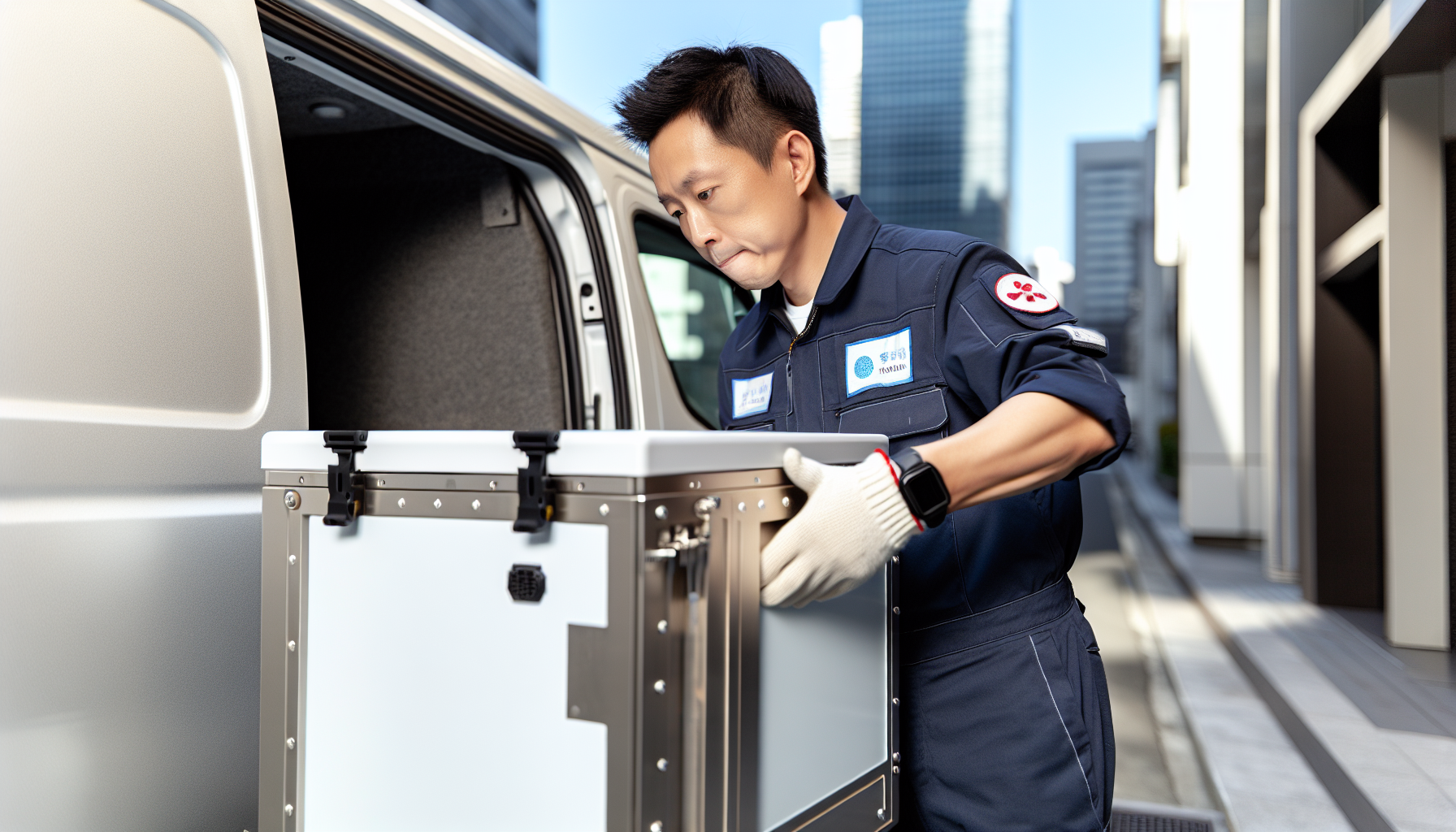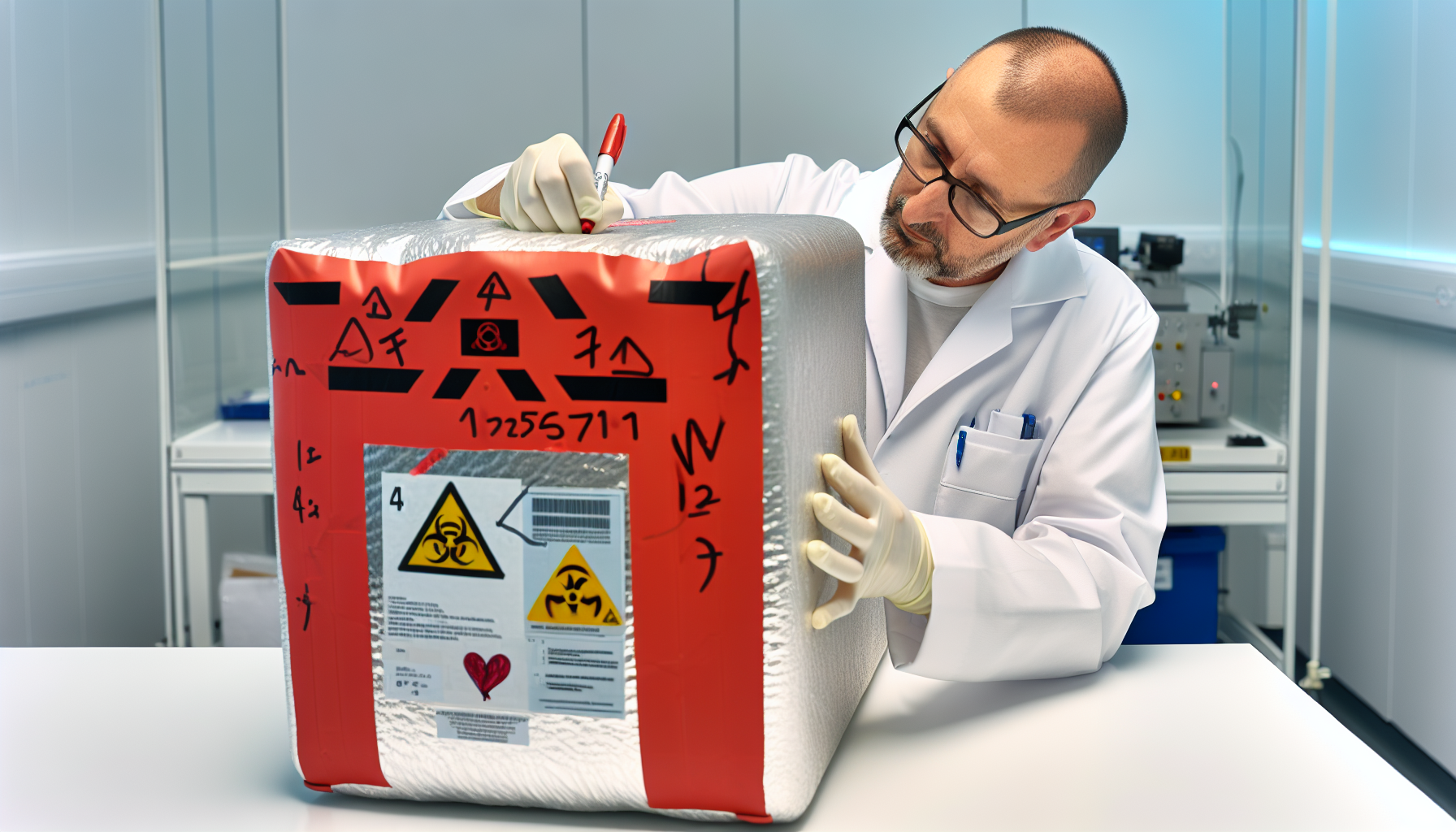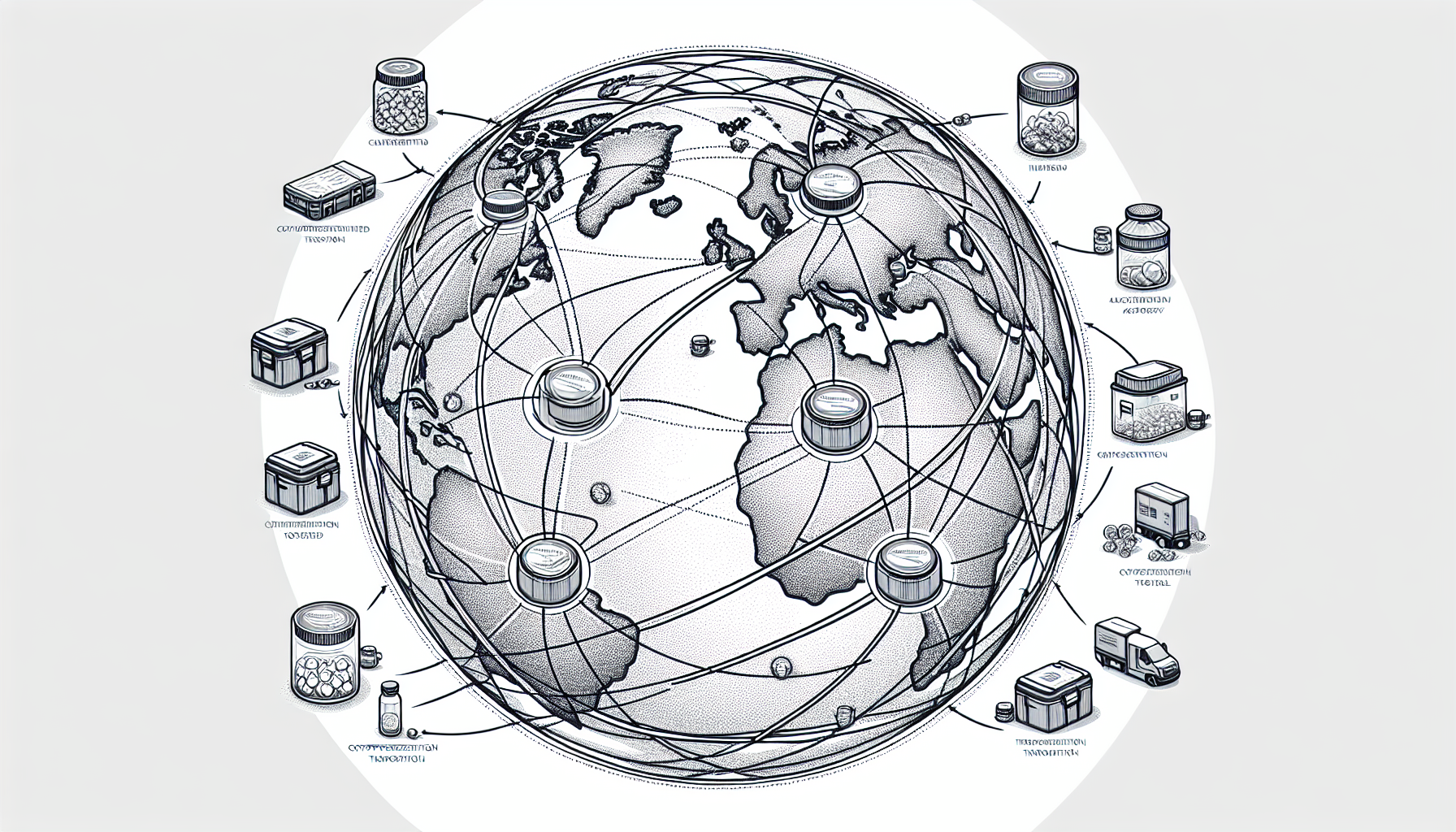What is cryotransportation and why is it crucial for modern biogenetics and reproductive medicine? Cryotransportation is the process of shipping temperature-sensitive biological materials, such as embryos, sperm, and eggs, at extremely low temperatures to preserve their viability. In this article, we’ll explore the intricate science of cryopreservation, the selection of reliable cryotransportation, otherwise known as cryoshipping, services, and the equipment and legal considerations that ensure these precious cargos reach their destinations intact.
Key Takeaways
- Cryotransportation, enabled by cryopreservation, is crucial for the reproductive fertility industry, facilitating the safe global transport of embryos, sperm, eggs, and stem cells without affecting IVF success rates.
- Selecting a reliable cryotransportation service requires careful consideration of experience, expertise in biomedical logistics, and robust risk management, with cost and service comparisons necessary to ensure value.
- Legal and logistical complexities, including meticulous customs paperwork, country-specific regulations, and technical transportation challenges, underscore the need for specialized knowledge in cryogenic shipping.
Understanding Cryotransportation


Cryotransportation is like a lifeline for the fertility industry. The transportation process involves moving reproductive cells, such as frozen embryos, from one location to another, safely. This process, known as embryo transport, ensures the best possible outcome for IVF treatments. The best part? Studies confirm that transport frozen embryos does not harm the success rates of IVF.
You might be intrigued by the safety of the transport process, and that’s where the science comes into play. The ability to freeze biological materials, like embryos, and transport them without compromising their viability is nothing short of a marvel. We shall delve deeper into this process.
The science behind cryopreservation
Cryopreservation is the real hero behind successful embryo transportation services. It’s a method where biological samples are cooled to extremely low temperatures to preserve them for long-term storage. This reduction in temperature reduces biological and chemical reactions, effectively putting a pause on biological processes in living cells.
Methods like slow freezing and vitrification are used in this process. Vitrification, in particular, is a rapid cooling method that transitions cells or tissues to a glass-like state without forming ice crystals, crucial for maintaining a high cell survival rate. Cryoprotective agents (CPAs) like glycerol and dimethyl sulfoxide (DMSO) play a vital role in minimizing ice crystal formation during freezing, thus protecting the cell membrane.
Types of biomaterials transported
Moving onwards, we shall discuss the ‘cargo’, or the biomaterials that undergo transportation. These include:
- embryos
- sperm
- eggs
- stem cells
These materials can maintain viability for decades, thanks to advanced cryopreservation techniques, making reliable transportation methods vital for long-term storage.
The transportation of human reproductive tissues has become a substantial aspect of the fertility industry. With a network of commercial entities dedicated to facilitating cross-border transport of gametes and embryos, individuals can now safely transfer their biomaterials between clinics and countries for assisted reproduction.
Selecting a Reliable Cryotransportation Service



Choosing a dependable cryotransportation service holds equal importance as the cryopreservation process. After all, it’s about ensuring the safe transport of your precious cargo. Specialized couriers like Cryoport, IVF Couriers, ARKCryo and EmbryoCouriers offer personalized cryogenic transportation of:
Between destination fertility clinics and medical laboratories across the globe.
It’s important to select a cryotransportation service with the following qualities:
- Significant experience and a proven track record
- Expertise in biomedical logistics and international customs
- Competence in managing unique circumstances
- Robust risk management and quality assurance protocols
One example of a cryotransportation service that meets these criteria is Cryoport Systems, which has over significant experience and expertise in this niche field. Their track record, combined with their knowledge in biomedical logistics and international customs, ensures their competence in handling reproductive materials. Engaging a cryotransportation service with these qualities is vital, given the emotional and financial stakes tied to these materials.
Key questions to ask potential couriers
Certain important questions need to be considered when choosing a courier. Here are some questions to ask:
- What is the courier’s experience, including the number of successful shipments per year and their overall failure rate?
- Does the courier service offer real-time GPS tracking?
- Does the courier service ensure constant supervision of the materials during transit?
Another important question to ask is about their contingency plan in case of failed shipments. Do they offer refunds or replacement shipping services? Verify if the company provides insurance that specifically covers maintaining cryogenic temperatures throughout the journey.
Finally, confirm that the embryo courier has the capability to ship to and from the destination country required for the transport of the gametes or embryos.
Comparing costs and services
Once you’ve narrowed down the potential couriers, the next step is to compare their costs and services. The cost of IVF cryotransportation varies greatly due to factors such as flight ticket prices, urgency, and shipment size. Also, different services offer varying levels of support. For instance, CryoStork offers varied service tiers, and First Egg Bank provides multilingual assistance, catering to international clientele.
While cost is a factor, it’s equally important to critically assess the relationship between service costs and quality. Consider factors such as shipment handling, simultaneous shipments, and the performance capabilities of the transportation equipment. The decision should balance cost considerations against service offerings to ensure biomaterials are transported safely and efficiently, without assuming that higher prices guarantee superior service.
Shipping Process and Equipment



Specialized equipment capable of maintaining cryogenic temperatures during transit is a must in the cryotransportation shipping process. One such essential piece of equipment is the ‘dry shipper.’ These units, like Cryo Express (CX) units, are designed to transport materials at cryogenic temperatures without spillage, even if tipped over.
Dry shippers utilize an absorbent material that holds the liquid nitrogen and keeps it from evaporating too quickly, thereby maintaining a temperature of approximately -190°C. The configurations of these shippers are carefully designed to accommodate specific numbers of vials or straws, ensuring proper organization and security for the cryopreserved materials.
Dry shippers and liquid nitrogen
During transit, dry shippers act as a life-support system for the valuable cargo. They use an absorbent material to hold liquid nitrogen and ensure the maintenance of cryogenic temperatures necessary for safe transport. The liquid nitrogen is pre-charged into dry shippers for 24 hours before shipment and is absorbed by a foam or sponge to maintain the required temperature throughout the journey.
However, just having a dry shipper filled with liquid nitrogen is not enough. To ensure the effectiveness of the dry shippers, they are regularly verified for performance and equipped with temperature data loggers to monitor conditions during transit. Also, safety and compliance with air transportation regulations are ensured through adherence to standards provided by the International Air Transport Association.
Packaging and labeling



Although dry shippers and liquid nitrogen handle temperature control, the packaging and labeling of the internal biomaterials play a significant role in ensuring their safety and viability. Cryotransportation packaging and labelling must adhere to specific requirements, including clear identification and necessary documentation for compliance.
The packaging process involves shipping embryos, delivering sperm in vials, and oocytes in straws to ensure their protection during transit. On the other hand, labels should include any necessary documentation for compliance, such as infectious disease testing results.
Continuous training is imperative for embryology and andrology personnel to minimize risks and adhere to proper packaging and transport procedures for cryopreserved materials.
Bypassing X-rays and other hazards
Cryotransportation goes beyond mere packing and shipping, it focuses on the safe transit of the valuable cargo, avoiding potential hazards such as X-rays. Cryotransportation containers use special markers or labels indicating ‘Do Not X-Ray’ to alert security personnel. Couriers receive special training to navigate security procedures at airports, coordinating with airport security for manual inspection over X-ray screening.
Moreover, effective negotiation with transport authorities is critical to avoid X-ray exposure during customs inspections. Even the containers are designed with protective measures, such as lead-lined cases or materials that inherently shield content, to prevent radiation exposure. Some couriers even offer real-time monitoring to ensure that the containers are not subjected to X-rays or other radiation.
Navigating Legal Restrictions and Customs
Beyond the technical challenges of cryotransportation, legal restrictions and customs navigation can further complexify the process. International transportation of gametes and embryos is influenced by:
- The need for better care
- Legal barriers
- Cost
- Legislative changes
These factors further complicate the process.
The need for a cryotransportation service with specific knowledge of varying laws and regulations between countries is paramount. For instance, the EU tissues and cells directive plays a significant role in the international shipping of gametes and embryos.
Understanding country-specific regulations
Each country establishes its own set of regulations for the cryopreservation and transportation of reproductive materials, including transporting frozen embryos internationally. Some countries impose restrictions that affect these processes, such as bans on egg freezing for nonmedical reasons and specific legislation regulating embryo freezing.
The legal restrictions on surrogacy in various countries necessitate a comprehensive understanding of those regulations, profoundly affecting international cryotransportation of eggs and embryos for intended parents. Hence, understanding these country-specific regulations is crucial for a smooth cryotransportation process.
Handling customs paperwork
Efficient handling of customs paperwork presents another challenge in the cryotransportation process. Services like ARKCryo assist clients by preparing all necessary customs paperwork in advance, assuring compliance with customs clearance standards.
It’s crucial to adhere to international shipping regulations, such as U.S. FDA regulations that stipulate specific testing, screening, and certification for the import of human cells and tissues. At the same time, effective communication and cooperation between sending and receiving clinics are essential to ensure that all required documents for the cryotransport process are prepared.
Real-Life Cryotransportation Stories



Apart from the technical and legal aspects of cryotransportation, the true-life experiences of individuals transporting cryopreserved biomaterials internationally offer a unique perspective. Individuals face a myriad of challenges, from logistics to compliance with varying legal frameworks.
However, not every aspect is challenging. Despite the challenges, many have found success, with stories of couples finally achieving pregnancy and childbirth thanks to the proper management of cryotransportation. Even fertility clinics now report higher success rates in procedures involving transported cryopreserved eggs, sperm, and embryos.
Overcoming obstacles
The path of cryotransportation is not always smooth. There are obstacles along the way. For instance, John Loewen suffered light burns due to a liquid nitrogen leak while transporting biological material on a flight to Bangkok. Then there was a woman who had to ensure her eggs were kept at temperatures between -196 and -200 ºC throughout her journey from Italy to Spain.
Jess Mcloughlin had a distressing experience with a poorly managed courier service when shipping her embryos, illustrating the importance of selecting a reliable cryotransportation service with personal service. These stories highlight the various obstacles individuals face during their cryotransportation journey.
Positive outcomes
In spite of the hurdles, the accounts of successful outcomes provide encouragement and motivation. The woman who traveled from Italy to Spain had 13 out of 14 of her eggs fertilized, and one of them resulted in a successful pregnancy and birth. John Loewen, despite his initial troubles, had twins through surrogacy using ivf samples.
A patient underwent three successful frozen embryo transfers, each resulting in a healthy birth, demonstrating cryotransportation’s role in successful assisted reproductive technology. These stories highlight the positive outcomes and the potential of cryotransportation in aiding individuals and couples in their journey to parenthood.
Summary
Cryotransportation is a marvel of modern science, enabling the safe and efficient transport of reproductive materials across the globe. From understanding the science behind cryopreservation to selecting a reliable cryotransportation service, we’ve delved into the complex world of this remarkable technology.
Despite the challenges, the stories of successful cryotransportation outcomes are a testament to the potential of this technology. As the technology advances and regulations adapt, the future of cryotransportation holds immense promise, helping individuals and couples turn their dreams of parenthood into reality.
Frequently Asked Questions
Can you fly with frozen embryos?
Yes, you can fly with frozen embryos as long as they are correctly handled during transportation, which should have no negative effect on their ability to create a pregnancy once thawed successfully. Therefore, it’s important to choose an experienced courier for the transport.
How do you transport embryos internationally?
The best way to transport frozen embryos internationally is by using a personal courier who can ensure the safe delivery of the samples from one facility to another. This is the most reliable method for transporting embryos.
Can you transfer your frozen embryos to another clinic?
Yes, you can transfer your frozen embryos to another clinic by using cryoshipping services provided by companies like BioCouriers. It’s a complex solution, but it’s possible to transport your embryos to a new clinic if needed.
Why would someone need to move their gametes to a new clinic?
You may need to move your gametes to a new clinic if you’re relocating, seeking a different doctor, or transferring materials for treatment. It’s essential to ensure a smooth transition for personalized care and convenience.








